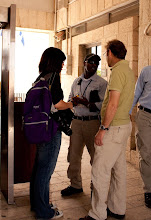ramallah is a mere 16 km outside jerusalem and is considered very liberal in comparison to the other west bank cities. the ride there was very interesting as the bus drove through givat shaul, a jewish settlement. although i knew the existence of several settlements, i had no idea that some were quite close to jerusalem and that there are more than just several. there are many! furthermore, due to many government headquarters, ramallah serves as the de facto capital of palestine. it is also where yassar arafat established his headquarters (and is buried?) and lots of diplomatic missionaries and NGOs work out of ramallah. it is also home to one of the most stingiest checkpoint (qalandia) in the west bank.
our stay in ramallah was quite short as we were just there to meet tim, our mutual friend who lives in al-bireh, who was going to be our designated tour guide for the day. after a short coffee break, we headed toward the central station to catch a taxi to nablus. nablus is the northernmost city of interest in the west bank. as ramallah is the center of government, nablus is the center of commerce and culture, known for its knafeh, a sweet goat cheese pastry, and olive oil soap. nablus is also home to one of the most stringent resistance to israeli occupation and has seen much rough action as a consequence. my well-worn lonely planet tells me that that the northern west bank is referred to by old testament purists as samaria* and there is quite a thriving samaritan community in nablus.
nablus was bustling by the time tim, jan, and i arrived. many were lounging about drinking turkish cafe or a refreshing yogurt with fruit. tim led us around the centre and then we dove right into the old city, walking around the myriad of stores and alleyways that date back to roman times in the 7th century. the people in nablus were very frank and openly gawked and twittered about our presence. i have come into terms that it wasn't tim or jan's presence but mine that garnered a lot attention. what can i say? asian looking people are a rarity in these parts. the children followed us, demanding that we take their pictures and yelling 'welcome!' every few minutes. it was also very odd feeling because while visiting other west bank cities, i was able to get a definite feel but nablus laid dormant.
because of nablus' history with resisting the occupation, there were many posters of boys and men carrying guns with the background of a palestinian flag or dome of the rock plastered all over the walls. tim said these posters are a commemoration to those who fought the occupation and died. these were completely idealized images of the people and while they were strongly political, there was something strangely pop cultural about them. the macho poses coupled with the heavy artillery were quite ridiculous.
it was insanely hot. so much so that the three of us were sweating copious amounts. so gross. to take a break, we ducked into a knafeh shop and sat down to enjoy some of the best that i have ever had. i am going to miss this pastry so much come two weeks. i had some good ones in nazareth and in hebron but the ones in nablus blow others out of the water. after a much deserved snack, we walked back toward the centre and explore an olive oil soap factory. because it is more expensive to use their own olive oil, oil from from spain and italy are imported. while the soap is mixed by machines that are quite old, cutting and drying are done by hand. upstairs, a great majority of the floor is covered with the wet soap for it to harden. afterwards, the soap is hand cut and towers of soap are constructed to further dry it out. the conical towers of asymmetrical soap provided a beautiful contrast in the room of grey stone.
six bars of soap later, we boarded a taxi to balata, one of the largest UNRWA refugee camps. over 15,000 people occupy a ridiculously small space of 1 kilometre square. it was supposed be a temporary residence for those thrust out of jaffa and nearby areas. but over the years, the tents gave way to concrete buildings with many as 40 people living on one floor/apartment. there is a program, yafa cultural centre, that try to ease the problems that arise from living in close quarters but it can only do so much. just as nablus resisted/is resisting the occupation, balata residents were also heavily involved in the palestinian intifadas. the living conditions in balata are miserable. the alleyways between the buildings are so tiny that large people cannot use them. there is no privacy. the economy is pretty much shot through the roof. the people still live with hope that they will be able to return to their homes. i can understand now, what heshem said about the palestinian support of hamas. in a situation like this, one can only hope for change.
sometimes, i think israel really, really sucks.
*there is so much history in this area and so many different conquest, i can hardly keep up with the changes. i have a newfound respect for those who study the complicated history of the middle east. sometimes facts are myths and myths are facts. if that makes any sense...

0 comments:
Post a Comment